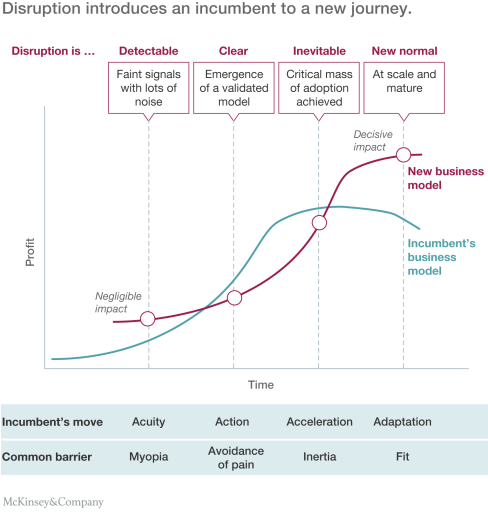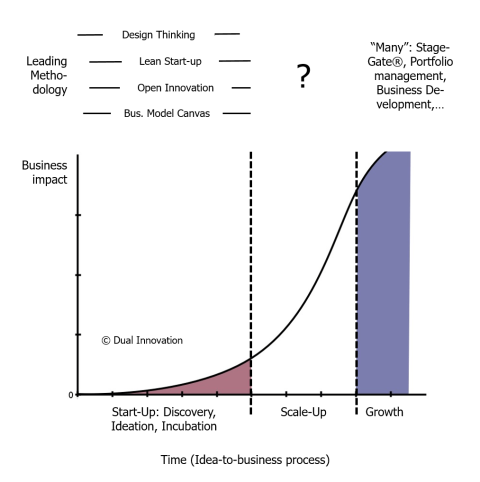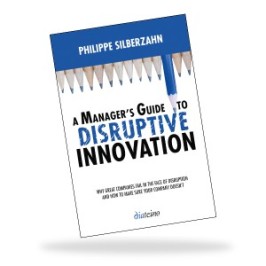Philippe Silberzahn, a consultant, keynote speaker, and associate professor at EM Lyon Business School, works with large companies confronted to disruptions in their markets: it was natural that he summarizes the mechanisms of disruption, in his book A Managers’Guide to Disruptive Innovation capitalizing on the various books of Clayton Christensen. Philippe doesn’t leave us unarmed, and suggests practical actions to transform, and reinvent your business model in face of disruptive competition.
I read his book with great interest, and Philippe kindly accepted to anwer the questions I raised. This post continues the conversation started here (questions 1 to 5).
6) Management systems adaptation for disruption
Nicolas: You demonstrate that “Management systems are blind to a creativity breakdown as they focus on current performance. As disruptive innovation takes place outside of the company’s value network, management systems cannot detect them”, and a few pages further on, “To be able to innovate disruptive, it is necessary to assure that the resource allocation process takes into account the non consumers”. Have you examples of companies who have managed to adapt their management system and resource allocation according to develop disruptive innovation? Is there a company that you would quote as exemplary in ‘creating a strategic capacity for disruptive innovation’, ticking all the boxes that are incentives for innovation, and “offsetting incentives that currently prevent people from innovation”: organization, process, culture, HR, and management systems?
Philippe: Unfortunately I am more in touch with the ones that struggle than with the ones that succeed. I think few do, and that’s a question today when we consider the future of large organizations. There is a view – call it the Silicon Valley view – according to which we should give up such organizations and that inevitably, they will be displaced by new entrants, in a kind of Schumpeterian creative disruption. Christensen’s theory seems to suggest indeed that incumbents will fail to respond adequately to disruptive change. I would not be so pessimistic. There is no reason why it should not be possible to respond. I think it only works when the top leadership put all their weigh on the disruptive unit at some crucial point.

7) Haste is one thing, speed another: Fail fast or Learn Fast?
Nicolas: “An incumbent can protect a disruptive project in a separate entity that will establish a completely new business model including a specific set of RPV”. “Scaling this value network will take time, it is complex and tedious, you better look for profit rather than sales”. “In an uncertain environment, the trial and approach, fail fast, fail early, will work poorly, risking giving up too early, and for the wrong reasons”. I was never convinced by the fail fast mantra, but more by the learn fast objective: confronting quickly one’s value proposition to the user target, learning from his feedback, and iterating in short cycles, until the product/market fit is proved, and the comprehensive business model is ready to scale. It is in short cycles, but it can actually take some time, and doesn’t translate in giving up quickly… So my advice would be to apply Business Model Canvas and Lean Startup to the corporate startup that will work on the disruptive project. What is your opinion?
Philippe: Different methods can be applied and they can provide value. The problem with the learning paradigm such as LS is: what do you learn? How do you interpret what you see? If Nespresso had used LS, they would probably have concluded quite quickly that the project was hopeless. In uncertain context, research has shown that we have causal ambiguity: you see stuff, you see customers’ reactions but you cannot easily explain it. Learning models assumes organizations respond to experience by repeating behaviors that have been found to be successful in the past, and avoiding those which have not. This has proven quite robust in situations where preferences are clear, alternative courses of action are specified in advance, and outcomes are unambiguous, but that is not the case in innovative contexts by definition: everything is new.
To this learning paradigm I oppose the shaping paradigm. Entrepreneurs, such as the ones using the practice of effectuation, don’t learn, they create new markets. It’s an entirely different posture.
![innovation[1]](https://nbry.files.wordpress.com/2018/03/innovation1.png?w=519&h=309)
Nicolas: I’m not convinced by the opposition between lerning, and shaping: you shape a new market by actually learning what the users do out of your solution. The faster you lern, the better you shape. Sometimes you are surprised by user reactions, and it creates new opportunities as you explain in the effectuation path: take benefit of surprises!
8) An approach yet to be defined for Corporate Scale-up?
Nicolas: Assuming the former phase of proving the business model is completed, the next stage would be to scale-up, bring the RPV to a broader dimension. And this time look for sales multiplication. Aside from the Scaling Lean d’Ash Maurya which is limited to startups, there doesn’t seem to be many methodologies to scale-up a corporate startup: what is your view on this? Is this a topic of interest for you?
Philippe: I mainly focus on the entrepreneurial period, i.e. getting projects from inception to the scale up phase so I don’t have much to say on this, except that scale up is when being part of an existing organization should provide a big advantage, providing potential conflicts with the legacy business are solved.

9) Modular design
Nicolas: In a recent post, you value the organization of Amazon, and the way it combines small teams (2 pizze team) with API-based design (in other words modular design) to remain creative, and entrepreneurial, when you’re growing at fast pace. In the Rapid Innovation platform, modular design is one of the 4 components to achieve a rapidly innovating organization: autonomy (separate unit), creative tension, strategic alignment, and modular design. Aren’t APIs a perfect way to sustain the relationship between the separate corporate startup, and the core company, “finding the balance between complete autonomy and lack of autonomy”? Have you already noticed disruptive innovations which are based on modular design with APIs?
Philippe: That’s key and Bezos’ approach is really interesting. But it is not modular. The word to describe it is near-decomposable. It means that you can decompose the organization into small units that are autonomous, but not completely. While they are autonomous, they are still part of a whole, they define the whole. The strength lies in this subtle mix of autonomy and collective identity.
Nicolas: Modules with little dependance but precise interface is precisely what I call Modular Design. By designing building block (APIs) that let other assemble them, Modular Design lets you create new business almost instantaneously. Moreover Modular design empowers the organization by letting others create value on top of them: with its creative components, Modular Design sustains organic innovation.
![jaks-modular-seating[1]](https://nbry.files.wordpress.com/2018/03/jaks-modular-seating1.jpg?w=320&h=220)
10) Clayton Christensen makes a mark with recent debates
Nicolas: Your book explains how it takes “Clayton Christensen work as a springboard to explore the topic of disruptive innovation”. You mention, and comment at the end on recent debates related to Christensen theory. Could you come back on your opinion on the Jill Lepore’s article? Do you agree with this answer ‘Necessary disruptions, state of paralysis?’ from Michael Graber in InnovationExcellence ?
Philippe: Well yes, disruption is a way to break an industry’s paralysis, but that is not Christensen’s argument. I think Lepore did not really understand Christensen’s theory. She writes about disruptive technology whereas Christensen talks about disruptive business models, and she accuses him of mistaking disruptions for progress. In fact nowhere do we find in Christensen’s work the idea that a disruption is good or necessary. It is something that happens, and Christensen studies the reaction of the incumbent to something that happens. Nothing more, nothing less. Is everything about disruptive change? No. Is disruption necessary? It’s another question. Is it a good thing? Again, it’s another question. Disruption is a phenomenon, one among others, that is worth studying. In short, I think Leopore’s article did not bring much to the table.
![mf_christensen_large[1].jpg](https://nbry.files.wordpress.com/2018/03/mf_christensen_large1.jpg?w=489&h=326)


1 Comment